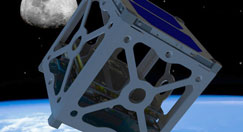Recent News
New director will enhance interdisciplinary engineering learning opportunities
July 2, 2025
Final SIRI cohort visits UNM campus
June 30, 2025
Perfetti receives ANS Landis Engineering Achievement Award
June 26, 2025
Engineering a new treatment for ovarian cancer
June 24, 2025
News Archives
Want to Learn how to Design and Build a Satellite?
October 20, 2011
 The University of New Mexico is looking for undergraduate students who are interested in learning to design, build and launch small satellites. The Configurable Space Microsystems Innovations and Applications Center (COSMIAC) has a new grant from the Air Force Research Laboratory University Phillips Technology Program to work with UNM and other universities to design, build and launch a small satellite in the next few years.
The University of New Mexico is looking for undergraduate students who are interested in learning to design, build and launch small satellites. The Configurable Space Microsystems Innovations and Applications Center (COSMIAC) has a new grant from the Air Force Research Laboratory University Phillips Technology Program to work with UNM and other universities to design, build and launch a small satellite in the next few years.
The universities involved include UNM, NMSU, NM Tech, NM Highlands, and University of Texas, El Paso. Students from the various universities will work on specific parts of the Space Environment Test Systems (SETS) Satellite.
Academic Programs & Design Services Director of COSMIAC Craig Kief says he is looking for students who will work with mentors to design a CubeSat that will accomplish several things.
- A proof of concept for the U.S. Air Force Research Laboratory’s SPA architecture. This will be the second COSMIAC CubeSat that will use off-the-shelf components will utilize the SPA technology with available off-the shelf components to integrate and optimize the various functions of a satellite. COSMIAC is working with AFRL to prove that small satellites can be constructed to work reliably at a much cheaper cost than current techniques allow.
- Carry a series of Langmuir Probes as part of an ongoing effort to monitor weather in the ionosphere. The Langmuir Probes will determine the electron temperature, density and the electric potential of the ionosphere as SETS travels through it.
- The Wind Ion Neutral Composite Suite (WINCS) is an instrument developed by NASA, The Naval Research Laboratory and NASA’s Goddard Space Flight Center. The instrument will record information in the ionosphere and thermosphere. Under tumultuous conditions, the energy carried by the solar wind can heat up in the thermosphere, which then expands and causes an atmospheric drag on orbiting spacecraft. That can make the craft return prematurely to Earth. This instrument will work with others on the CubeSat to help scientists better understand the dynamics of the ionosphere.
- The craft will also have articulated solar panels that can pivot to face the sun without changing the orientation of the craft. This is critical since solar power is the only source of energy for the small (4”x8”x12”) spacecraft.
- The SETS will also have two software defined radios. The data rates on the radios can be altered so that information is sent to a receiver on earth very quickly when the spacecraft is positioned overhead where reception is best, and sent at a much slower rate when the spacecraft is positioned in portions of the sky where data transmission is more difficult. SETS will also be able to communicate with other NASA spacecraft while in orbit.
- SETS will carry a dosimeter to measure radiation levels as it travels through the ionosphere.
Designing and building the CubeSat will take several semesters so Kief says they are particularly interested in attracting undergraduate students who can stay with the program from the beginning. Students interested in becoming part of the program can look for the upcoming course on small spacecraft design that will be offer by Asal Naseri in Electrical and Computer Engineering in spring 2012.
This joint effort is now in the organizational stage. For more information, contact Cosmiac’s Craig Kief at craig.kief@cosmiac.org or Christos Christodoulou at christos@ece.unm.edu
